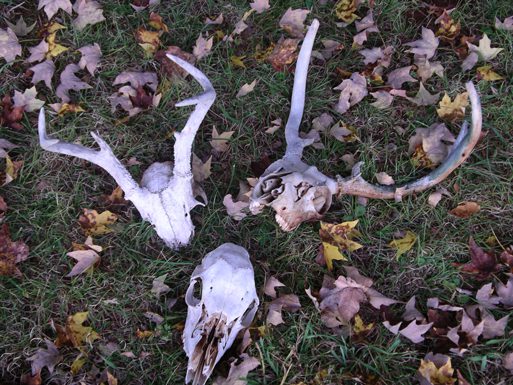Skulls

The weeks following deer season are typically busy for taxidermists in the Uwharries. Some hunters might be reluctant to part with several hundred dollars right now, even for a prized buck, but a European or skull mount can often be done for less than half the price of a traditional mount. Billy Adams, head of the taxidermy program at Montgomery Community College, says this option is becoming more popular. No doubt. Restoration Hardware now offers a collection of cast resin skulls – a sure sign they’ve become a trendy decorating accessory.
Doing the work yourself is even cheaper. I know a woman who amassed a collection of about 100 skulls, primarily via roadkill. She kept latex gloves, plastic garbage bags and trauma scissors in her trunk. She tried and discarded different methods of cleaning – boiling was stinky and bleaching compromised the strength of the bone. She finally decided to go the natural route and enlist the aid of maggots and beetles. She simply tossed a carcass under some shrubs in her backyard and waited. Unfortunately, an animal dragged it off. After that, she placed a milk crate over the carcass and secured it with tent stakes. Depending on the weather and the size of the skull, the cleaning process took anywhere from a few weeks to a few months.
Even though she once joked about being tempted to swerve to acquire an armadillo, she had a serious code of ethics. She wouldn’t take a threatened or endangered species, dead or alive, and she got hunting permits for game species like bear and deer. She recently donated her collection to a grateful natural history museum.
Last fall, I tried her method with a squirrel. Things went well for several weeks, until the day I checked and there was nothing left except the tail. I assume the thief – maybe a weasel – squeezed through the openings at the handles. I’m ready to make improvements and try again, but I still prefer to find a skull after nature has attended to the work.
Spend enough time outdoors in the Uwharries and you’re bound to run across a few. We’ve picked up several white-tailed deer. They’re a common species, and they often meet their demise in close proximity to humans. Their skulls are large, making them easy to spot and more apt to remain intact. I once found what I believe was a possum, but it disappeared before I was able to check it against the photos in my field guide.
 My best find came during a trip to visit my husband’s aunt and cousins in Devon, England. Their farm abuts Dartmoor National Park. Sheep range freely on this protected grassland, much like cattle do on public land out West. Given the harsh conditions and lack of oversight, mortality rates are higher than for those corralled in pastures. In addition, remote corners of the moor are regularly used as a bombing range. Schedules are posted to ward off hikers, but alas, sheep can’t read. It didn’t take much detective work to figure out we had a sheep skull as a souvenir.
My best find came during a trip to visit my husband’s aunt and cousins in Devon, England. Their farm abuts Dartmoor National Park. Sheep range freely on this protected grassland, much like cattle do on public land out West. Given the harsh conditions and lack of oversight, mortality rates are higher than for those corralled in pastures. In addition, remote corners of the moor are regularly used as a bombing range. Schedules are posted to ward off hikers, but alas, sheep can’t read. It didn’t take much detective work to figure out we had a sheep skull as a souvenir.
A skull can tell you a lot about an animal even if you can’t identify the species. Teeth are a clue to the animal’s diet. Carnivores have prominent canines to capture and puncture prey. Herbivores cut plant material with sharp incisors and use wide molars to grind it. Omnivores tear and chew a variety of food, so they have a crazy assortment of teeth. Eye socket size can indicate whether an animal was nocturnal or diurnal. The placement of the sockets can help you deduce whether an animal was predator or prey. One of my field guides has a helpful reminder – “Eyes in front, likes to hunt; eyes at side, likes to hide.”
Some people might find this topic a little creepy, but fans of shows like Bones and CSI probably understand the fascination with skulls. Human beings are curious creatures, natural-born detectives. We want to make sense of our world. Stripped of flesh, skulls offer us a glimpse at mysterious sockets, knots and fissures. They look vulnerable yet fierce. It’s hard to resist creating a story from these tantalizing bits of evidence.
For more information on this topic, scroll to the links at the end of this article.
Photographs by Ruth Ann Grissom
Books and field guides on skulls, bones and skeletons:
Skulls and Bones – Glen Searfoss
Bones, the Unity of Form and Function – R. McNeil Alexander
Skeleton – Steve Parker/Eyewitness Books
Illustrated Key to Skulls of Genera of North American Land Mammals – Knox Jones & Richard Manning
Peterson Field Guide to Mammals of North America – Fiona Reid
Animal Skulls and Bones (Duraguide pamphlet) – James Kavanaugh